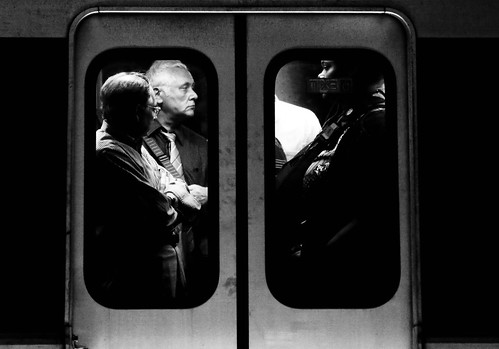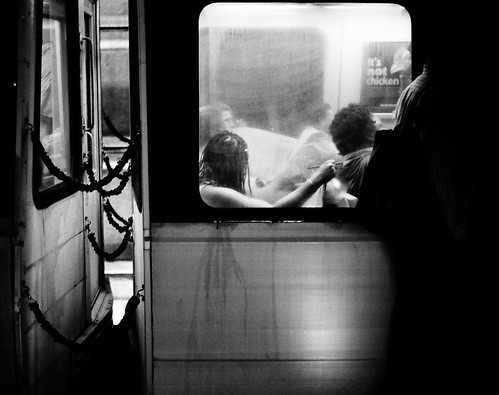
‘Where To Set One’s Eyes’ courtesy of ‘Bogotron’
It’s been a month since the fatal Red Line crash outside of Fort Totten. You’d think a deadly event like that would force some changes over at Metro at how they do things, right? More accountability, more transparency, better oversight, more concern for public safety..
Initially, I was impressed on the fact that they were at least trying. Despite some hard questions. Now, however, I’m not so sure.
Everyone by now has heard about the Post’s pretty damning report regarding Metro and the continual widespread failure of track circuits on four of the five lines. Incredibly scary stuff; those circuits are used to keep track of trains, their speed and location. The failure of such a circuit seems to be the cause of last month’s accident – though the NTSB has not officially announced the actual cause. Metro rail chief Dave Kubicek has downplayed the Post’s report, saying that none of the problems detected are anything close to the track circuit problem at the crash site. He insisted again that “the rail system is safe” and that it’s “a gross exaggeration” to suggest it’s widespread.
What is troubling isn’t just the technology failure; it’s how Metro’s handling it and other issues that have popped up lately.

‘It’s Not Chicken’ courtesy of ‘Bogotron’
Part of the Post’s sources were obtained from internal agency documents, which show at least six other problem circuits. They also show that Metro technicians have detected malfunctions since at least July 11 and possibly earlier. Keep in mind that Metro GM John Catoe said publicly last Thursday – July 16 – that WMATA had inspected all 3,000 circuits and didn’t note any problems. Clearly there’s a disconnect at WMATA and it isn’t all from faulty track circuits.
Catoe took the Post to task last night, however. WUSA9 reported that Catoe refuted the article’s assertions that the problem is widespread. “This was an example of someone taking information, not understanding the information and misreporting it,” he said last night. Not sure what’s to misunderstand here; if internal reports showed that there are six consistent problems located around the system, then that’s a pretty big issue.
Let’s just conveniently forget that those documents contradict Catoe’s public statements. (Why not? Catoe does it all the time now.)
Remember the whole mess in the days after the accident and the news about the 1000 series safety came to light? Catoe said Metro would be moving the older cars into the middle of trains, a suggestion put forth initially by Metro Union Local 689. He mentioned it would take a couple weeks for that to work through the system. It’s not all being done – one of our readers managed to catch a 1000-series car at the tail-end of a train yesterday.
Maybe it’s an anomaly, like a faulty track circuit. Problem is, it just continues to sully WMATA’s image, much like the few operators who have been caught sleeping, reading and (possibly) newspapering their cabins. Union representative Jackie Jeter’s response was pretty whiny, but the base effect is that it still casts a pretty bad light on the agency as a whole. And there’s apparently no end in sight.
Seems Metro’s been doing some internal damage control as well. The Fredrick County News-Post reported today that many Metro employees no longer have access to those computer reports regarding track circuitry. Workers in maintenance yards and control rooms had free access to those reports, which are used to troubleshoot the problems – but not anymore. Those computers with access are now locked down with password protection. When asked, Metro spokesman Steven Taubenkibel told the paper that “on or about July 3, there were some password changes to certain computer applications.”
The reports accessed weren’t the ones used by WaPo; The News-Post had obtained through internal Metro sources on June 25 several copies of documents that showed a track impedance bond had been malfunctioning after its June 17 installation, five days before the crash.
Two of the paper’s sources, who remain anonymous, discovered on July 3 that they no longer have access to the records. National media outlets had by then picked up The News-Post story and ran with it. Metro’s subsequent actions seem to indicate the agency is more concerned with damage control and image protection, rather than focusing on you know, passenger safety.
The union has been aware of the issue; it’s on a list of about 50 other safety issues they recently submitted to WMATA’s administration. According to the union, they are working with WMATA to address the concerns in-house.
Still, you can’t help but get the feeling that Catoe and Company aren’t necessarily concerned with passenger safety and resolving the issue, but rather how the agency is appearing in the public eye. While public image is important – no one wants to look incompetent or incapable of doing their primary job, which for Metro is transporting hundreds of thousands of people safely, every day – it cannot be put before the issues at hand. Like, you know, public safety. But that seems to be what is happening at WMATA headquarters. And I suspect – thought I hope it’s not the case – that it’s some twisted plot of theirs to wring more money from their various sources, including the stimulus bill and the public. (I won’t be shocked if next year they announce fare hikes and use this crash as their “safety issue” crutch to force sympathy.)
Each of these things are concerning when taken separately. But putting them together makes it even more problematic – and scary. Hundreds of thousands of people are reliant on the transit system to get them to and from work and other destinations every single day; do we really have to worry about our personal safety when we step on that train? It’s bad enough we have to deal with the minor inconveniences like tourists, nonfunctional AC units and broken escalators. (And Red Line riders are already on the brink, thanks to continued long delays on the system.) Do we need to add the specter of fear as well?
I do want to commend many of the Metro employees who have done an amazing job of keeping a smile on their face, however. Last night during the Orange / Blue line problems at Farragut West and McPherson, our operator came on the speakers every few minutes to keep us informed of the situation, maintaining a cheeriness that helped alleviate (a little) the crowded conditions in the station and car. (And for once, I was in a car where the loudspeaker actually WORKED.) So to that tireless majority – the ones not sleeping, reading or doing other things while operating a transit vehicle – I give a hearty “thank you.” You’ve done an amazing job despite all the scrutiny and image-bashing of your employer.
At least I don’t feel like you’re laughing behind my back. Can’t say the same when it comes to Catoe and his retinue on the Executive Board, however. I really hope I’m just being paranoid.
Because it’s not worth the lives at stake.




Great photo by Mike Bogotron.
Hear hear. Absolutely inexcusable on Catoe’s part.
Pingback: Update on Cell Phone Bus Driver » We Love DC
Pingback: Talkin’ Transit: Labor Pains » We Love DC